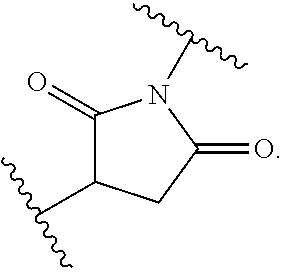Semisynthetic derivatives of Nystatin A1
a technology of nystatin and derivatives, which is applied in the field of nystatin a'semisynthetic derivatives sub > 1 /sub>, can solve the problems of invasive candidoses and aspergillose infections, the chemotherapy of fungal infections is one of the most difficult and not yet successfully solved in modern medicine, and the infection of internal organs by fungemia is still a problem far from being solved
- Summary
- Abstract
- Description
- Claims
- Application Information
AI Technical Summary
Problems solved by technology
Method used
Image
Examples
example 1
Synthesis of N-Succinimidyl Derivatives of Nystatin A1
[0147]200 mg (0.21 mmol) of Nystatin A1 is dissolved in 4 ml of dimethyl formamide (DMF) in 100 ml round-bottomed flask equipped with a magnetic stirrer. The solution is cooled to 0° C. and 0.029 ml (0.21 mmol) of triethylamine (TEA) is slowly added. After 10 minutes 0.25 mmol of the appropriate maleimide is added and the reaction mixture is warmed to room temperature. The reaction progress is monitored by thin layer chromatography (TLC) on Silica Gel (60 F254, Merck) in chloroform:methanol:water (20:8:1 v / v) solvent system. After then, the reaction mixture is added dropwise to 150 ml of diethyl ether. The resulting, pale yellow precipitate, is filtered under reduced pressure on a Millipore funnel. The crude product is twice washed with diethyl ether (2×50 ml) and then dried in a vacuum desiccator. The residue is purified by column chromatography on normal phases, where the solid phase is Silica Gel and solvent system is chlorof...
example 2
Synthesis of N—(N′-Alkyloamino)Succinimidyl Derivatives of Nystatin A1
[0158]200 mg (0.21 mmol) of Nystatin A1 in 4 ml of dimethyl formamide (DMF) is dissolved in 100 ml round-bottomed flask equipped with a magnetic stirrer. The solution is cooled to 0° C. and 0.029 ml (0.21 mmol) of triethylamine (TEA) is slowly added. After 10 minutes 0.42 mmol of the appropriate basic maleimide is added and the reaction mixture is warmed to room temperature. The reaction progress is monitored by thin layer chromatography (TLC) on Silica Gel (60 F254, Merck) in chloroform:methanol:water (10:6:1 v / v) solvent system. After then, the reaction mixture is added dropwise to 150 ml of diethyl ether. The resulting, pale yellow precipitate, is filtered under reduced pressure on a Millipore funnel. The crude product is twice washed with diethyl ether (2×50 ml) and then dried in a vacuum desiccator. The residue is purified by column chromatography on normal phase, where the solid phase is Silica Gel and solv...
example 3
Synthesis of N-Thioureidyl Derivatives of Nystatin
[0171]200 mg (0.21 mmol) of Nystatin A1 is dissolved in 4 ml of dimethyl formamide (DMF) in 100 ml round-bottomed flask equipped with a magnetic stirrer. The solution is cooled to 0° C. and 0.029 ml (0.21 mmol) of triethylamine (TEA) is slowly added. After 10 minutes 0.25 mmol of the appropriate isothiocyanate is added and the reaction mixture is warmed to room temperature. The reaction progress is monitored by thin layer chromatography (TLC) on Silica Gel (60 F254, Merck) in chloroform:methanol:water (10:6:1 v / v) solvent system. After then the reaction mixture is added dropwise to 150 ml of diethyl ether. The resulting, pale yellow precipitate, is filtered under reduced pressure on a Millipore funnel. The crude product is washed twice with diethyl ether (2×50 ml) and then dried in a vacuum desiccator. The residue is purified by column chromatography on normal phase, where the solid phase is Silica Gel and solvent system is chlorofor...
PUM
| Property | Measurement | Unit |
|---|---|---|
| temperature | aaaaa | aaaaa |
| concentration | aaaaa | aaaaa |
| concentration | aaaaa | aaaaa |
Abstract
Description
Claims
Application Information
 Login to View More
Login to View More - R&D
- Intellectual Property
- Life Sciences
- Materials
- Tech Scout
- Unparalleled Data Quality
- Higher Quality Content
- 60% Fewer Hallucinations
Browse by: Latest US Patents, China's latest patents, Technical Efficacy Thesaurus, Application Domain, Technology Topic, Popular Technical Reports.
© 2025 PatSnap. All rights reserved.Legal|Privacy policy|Modern Slavery Act Transparency Statement|Sitemap|About US| Contact US: help@patsnap.com



